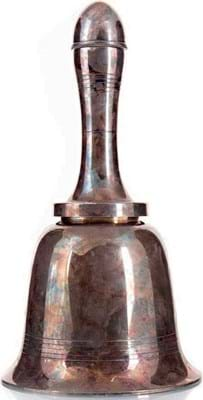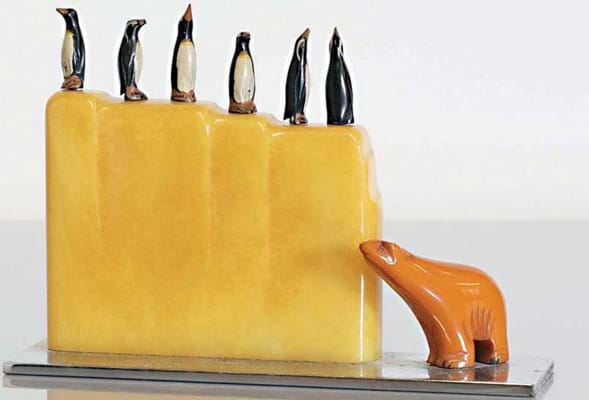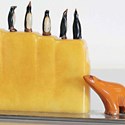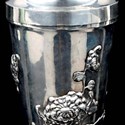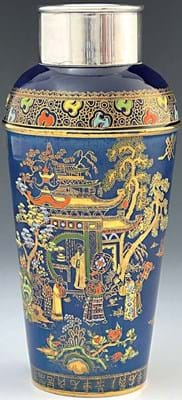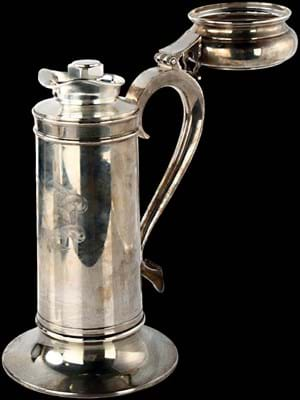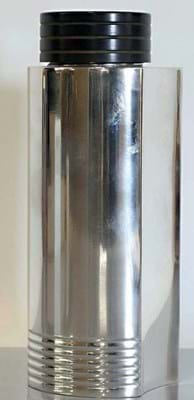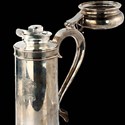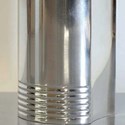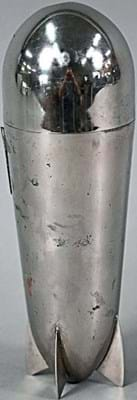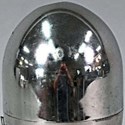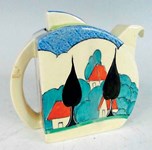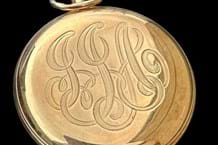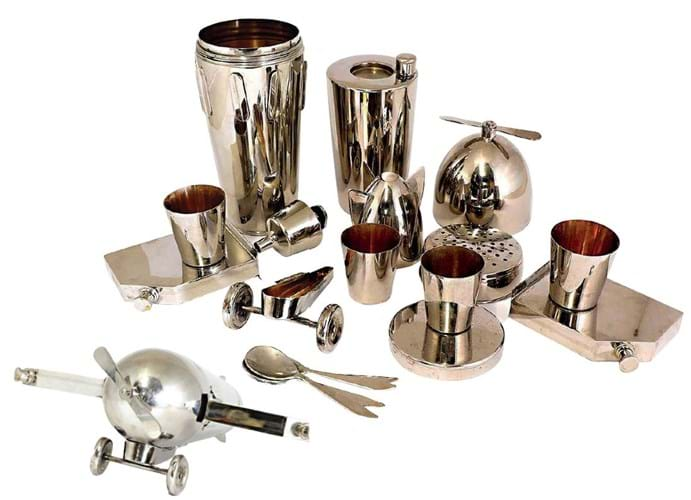
The 15 or so component parts of a JA Henckels 13in (32cm) monoplane cocktail set, £6500 at Sworders in May 2022.
Twenty-five years ago in July 1998, Simon Khachadourian, proprietor of London’s Pullman Gallery, opened his St James’s shop with an exhibition devoted to the cocktail shaker.
Opening night had coincided with the summer party at next-door-neighbour Christie’s and he had been pleased to sell three pieces off the bat – including a silver shaker by the Meriden International Sterling Company once owned by the Chicago racketeer Alphonse Capone. Priced at £1800, it was inscribed To A ‘Regular Guy’ From The Boys and dated 1932, the year Capone began a 10-year jail sentence.
Khachadourian followed up his exhibition by publishing The Cocktail Shaker in 2000. Filled with anecdotes, archive photographs and countless images of rare and classic shakers, it sold out its print run of 10,000 within six months.
It was the beginning of a social media-fuelled renaissance that took cocktails to new levels of popularity. How better to convey your ‘best life’ on Instagram than by mixing a mojito in a vintage shaker?
Inter-war excitement
While some of the earliest drinks mixers date back to the 1870s, the first ‘golden age’ of the cocktail shaker was the inter-war decades – the era of the cocktail party, the night club and the speakeasy.
As the US threw off the shackles of Prohibition and hipsters partied through the Depression, there was an explosion of designs in silver, silver plate, glass and chrome.
The list of manufacturers who made cocktail shakers and accessories in the 20s and 30s reads like a roll-call of the great luxury houses of the early 20th century: Asprey, Cartier, Tiffany, Alfred Dunhill, Louis Vuitton, Puiforcat, Lalique and Baccarat.
Most were relatively simple ‘streamlined’ three-piece models. On a purely functional level, Khachadourian recommends the classic Tiffany silver shaker (“they are beautifully made and won’t ever leak”). However, it was the novelties that really made the party swing.
Perhaps the first of the ‘figurals’ was a golf bag shaker issued by the Derby Silver Plate Company of Connecticut in 1926 (see picture below). By the time the thirst for new designs was quenched by the onset of the Second World War and the arrival of the electric blender, there were cocktail shakers formed as dumbbells, handbells, champagne bottles, tanks, ship’s lanterns and penguins.

Asprey & Co silverplated single handled The Thirst Extinguisher cocktail shaker, modelled as a fire extinguisher, Ewbank’s, Woking, April 20, £1400.
Some were hugely expensive at the time. The much-cherished Thirst Extinguisher modelled as a fire extinguisher introduced to the Asprey range in 1932 was priced at a cool 25 guineas.
Drinks take flight
The lesser-known firm responsible for some of the most coveted cocktail shakers was JA Henckels of Dusseldorf. It was the German cutler that created classic drinking novelties such as the Zeppelin, the skyscraper and the lighthouse.
Among Henckels’ most ambitious creations, and the epitome of 1930s glamour, was a electroplated steel cocktail set or ‘travelling bar’ fashioned as a monoplane. The 15 or so component parts include a pair of spirit flasks that form the wings, a cocktail shaker (the fuselage) plus four interlocking beakers, a funnel and four spoons and a corkscrew.
There are two production-line versions – one with a 9in (23cm) wingspan, the other larger at 13in (32cm). However, a seemingly unique 18in (46cm) example made for an exhibition in 1927 sold for a record $50,000 at Phillips New York in 2001, bought at the time by an unshaken Khachadourian.
A Prohibition-themed sale, held by Sotheby’s New York in 2020 to mark the centenary of the passing of the 18th Amendment, set some of the recent benchmarks for Jazz Age cocktail shakers. In particular, the sale included an ‘ebony’ version of the Bakelite and electroplated shaker from the Master Incolor range manufactured by De La Rue.
To the collar is a rotating ring embossed with eight different classic cocktail recipes: Clover Club, Dry Martini, Manhattan, Whisky Sour, Tom Collins, Orange Blossom, Side Car and Bronx.
Sotheby’s example, estimated at $2000-3000 sold for $19,000. But don’t be too stirred. More typically, dependent on colour and condition, they bring between £500-1500 at auction.
And that cocktail shaker belonging to Al Capone? Famously it reappeared for sale at Sotheby’s as part of the Stanley Seeger (1930-2011) sale in 2014.
After the auction, Khachadourian had been good enough to chat with presenter Chris Evans on BBC Radio 2 when he explained its history (he had bought it from the family of one of Capone’s ‘Boys’) and lamented parting with it for a fraction of its final selling price of £40,000.
Novelty productions
Two ‘golden age’ era novelties available to purchase from specialist dealers are shown here.
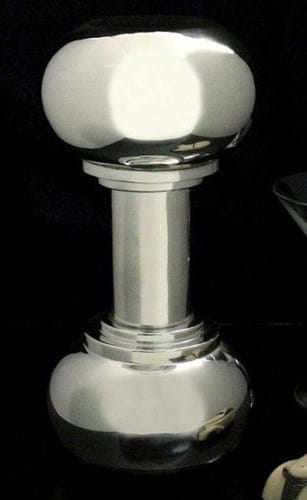
Dumbbell cocktail shaker made by Asprey & Co, priced at $3800 by US dealership Cherub Antiques Gallery.
“A bold form and ideal for actual shaking”, this dumbbell is among the many novelty cocktail shakers made by Asprey & Co at the height of the Art Deco period. Dating to c.1930, the 10.5in (27cm) high example in silver plate is priced at $3800 by US dealership Cherub Antiques Gallery.

Golf bag cocktail shaker with six cups designed in 1926 by George H Berry for The Derby Silver Plate Company of Connecticut, priced at £18,500 by the Pullman Gallery.
This scarce, silver-plated golf bag cocktail shaker with six cups was designed in 1926 by George H Berry for The Derby Silver Plate Company of Meriden, Connecticut. Considered the first novelty cocktail shaker, this example with six cups is priced at £18,500 by the Pullman Gallery in St James’s, London.


